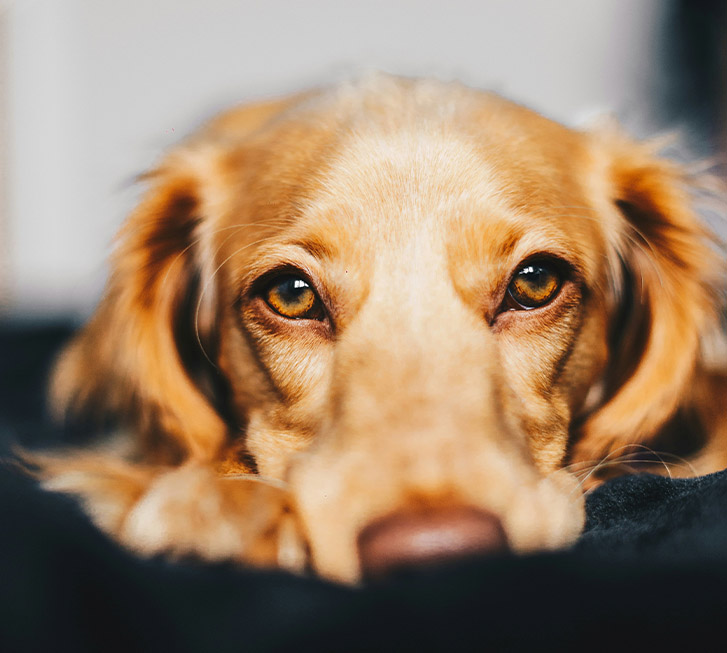Cruciate ligament injuries are common among dogs and can significantly impact their mobility and overall quality of life. By understanding this crucial aspect of canine anatomy, recognising the signs of injury early, and taking prompt action by seeking veterinary care, dog owners can play a vital role in ensuring the well-being of their furry friends. Pet Insurance Australia investigates cruciate ligaments in dogs, including their function, injury symptoms, standard treatments, and preventive measures.
What is the Cruciate Ligament in a Dog and Its Function?
The cruciate or cranial cruciate ligament (CCL) or anterior cruciate ligament (ACL) is a vital structure in a dog’s knee joint. It plays a crucial role in stabilising the knee during movement by preventing excessive forward movement and rotation of the shin bone (tibia) relative to the thigh bone (femur). It helps maintain the structural integrity of the knee joint and facilitates smooth, controlled movement.
Can a Dog Heal on Its Own with a Cruciate Ligament?
Unlike some minor injuries, cruciate ligament damage typically requires veterinary intervention for proper healing. While some dogs may show temporary improvement or appear to “heal” on their own, the underlying ligament damage often persists and can lead to long-term complications if left untreated. This underscores the importance of seeking professional veterinary treatment at the earliest signs of injury, as it can prevent further damage, alleviate pain, and restore mobility.
Can a Dog Walk with Cruciate Ligament Damage?
Dogs with cruciate ligament damage may still attempt to walk, but their gait is often altered, and they may experience pain and discomfort. It is important to remember that dogs are masters at masking their pain. Depending on the severity of the injury, some dogs may bear weight on the affected leg while others may limp or avoid putting weight on it altogether. However, attempting to walk with a damaged cruciate ligament can exacerbate the injury and lead to additional complications.

How Do I Know if My Dog Has Hurt Their Cruciate Ligament?
Recognising the signs of cruciate ligament injury is crucial for early intervention. Common symptoms include:
- Limping or lameness, especially after exercise or prolonged activity.
- Reluctance to bear weight on one or both hind legs.
- Swelling or thickening around the knee joint.
- Difficulty rising or climbing stairs.
- Audible popping or clicking sounds coming from the knee joint.
- Decreased range of motion in the affected leg.
If you notice any of these symptoms in your dog, you must consult a veterinarian promptly for a thorough evaluation and diagnosis.
How Do They Diagnose Cruciate Ligament Injuries in Dogs?
Veterinarians typically diagnose cruciate ligament injuries through a combination of physical examination, manipulation of the affected joint, and imaging tests such as X-rays or advanced imaging techniques like MRI or CT scans. These diagnostic methods help assess the extent of ligament damage and determine the most appropriate course of treatment.
Common Treatments for Cruciate Ligament Injuries in Dogs
Treatment options for cruciate ligament injuries in dogs vary depending on the injury’s severity and the patient’s individual needs. However, it’s important to note that with the right treatment, dogs can often recover and regain their mobility. Common treatments include:
- Conservative management: Rest, restricted activity, and anti-inflammatory medications may be recommended for mild cases or for dogs who are not good candidates for surgery.
- Surgery: For more severe or unstable injuries, surgical intervention, such as Tibial Plateau Leveling Osteotomy (TPLO), Tibial Tuberosity Advancement (TTA), or Extracapsular Repair, may be necessary to stabilise the knee joint and promote healing.
- Rehabilitation therapy: Physical therapy, hydrotherapy, and other rehabilitative techniques can help improve strength, flexibility, and mobility during the recovery process.
Typical Recovery Time from Cruciate Ligament Injuries
The recovery time for dogs with cruciate ligament injuries can vary depending on the severity of the injury, the chosen treatment method, and the patient’s individual characteristics. In general, dogs undergoing surgical intervention may require several months of rehabilitation and restricted activity to recover fully, while those treated conservatively may experience shorter recovery periods. This information can help dog owners prepare for the recovery process and understand the commitment required for their dog’s full recovery.
Prevention of Cruciate Ligament Injuries
While not all cruciate ligament injuries can be prevented, responsible dog owners, can take specific measures to help reduce the risk:
- Maintain a healthy weight: Obesity increases the risk of ligament injury and exacerbates existing joint problems. Keep your dog at a healthy weight through proper diet and regular exercise.
- Avoid high-impact activities: Limit activities that strain the knees excessively, such as jumping or rough play, especially in breeds prone to ligament injuries.
- Provide joint support: Consider supplements or diets formulated to support joint health, particularly for senior dogs or breeds predisposed to musculoskeletal issues. It is important to always speak to your veterinarian before administering any additional supplements into your dog’s everyday diet.
Common Breeds Affected and Why
Certain dog breeds are more prone to cruciate ligament injuries due to conformation, genetics, and activity level. Commonly affected breeds include:
- Labrador Retrievers
- Golden Retrievers
- Rottweilers
- German Shepherds
- Boxers
These breeds often have a combination of factors, including size, weight, and predisposition to orthopaedic conditions, that increase their susceptibility to cruciate ligament injuries.
Understanding cruciate ligaments in dogs, recognising the signs of injury, seeking prompt veterinary care, and implementing preventive measures are essential for maintaining your dog’s mobility and well-being. If you suspect your dog has a cruciate ligament injury, don’t hesitate to consult a veterinarian for proper diagnosis and treatment. Your furry friend will thank you for it with wagging tails and joyful romps in the park.
Key Points: Understanding Cruciate Ligaments in Dogs
- Cruciate Ligament Injuries: Common among dogs, cruciate ligament injuries significantly affect mobility and quality of life. Recognizing early signs and seeking prompt veterinary care is crucial.
- Function of Cruciate Ligament: The cranial or anterior cruciate ligament stabilizes the knee during movement, preventing excessive forward movement and rotation, ensuring smooth, controlled movement.
- Professional Treatment Necessary: Unlike minor injuries, cruciate ligament damage usually requires veterinary intervention. Self-healing can mask underlying damage, leading to long-term complications.
- Altered Gait with Injury: Dogs may attempt to walk with cruciate ligament damage, but their gait is often altered, and they may experience pain. Walking with a damaged ligament can worsen the injury.
- Recognising Symptoms: Symptoms include limping, reluctance to bear weight, swelling, difficulty rising, audible sounds from the knee, and decreased range of motion.
- Diagnosis Methods: Veterinarians diagnose through physical examination, joint manipulation, and imaging tests like X-rays, MRI, or CT scans to assess the extent of damage.
- Treatment Options: Treatments vary based on severity and can include rest, surgery (TPLO, TTA, or Extracapsular Repair), or rehabilitation therapy.
- Recovery Time: Recovery time depends on severity and treatment method. Surgical cases may require months of rehabilitation, while conservative cases may recover faster.
- Prevention Methods: Maintaining a healthy weight, avoiding high-impact activities, and providing joint support can reduce the risk of injury.
- Common Breeds Affected: Breeds like Labrador Retrievers, Golden Retrievers, Rottweilers, German Shepherds, and Boxers are prone to cruciate ligament injuries due to factors like size, genetics, and activity level.
Understanding cruciate ligaments, recognising injury signs, seeking timely care, and implementing preventive measures are crucial for maintaining dogs’ mobility and well-being. Consult a veterinarian for personalised advice and treatment options.
Disclaimer: This blog is for informational purposes only and should not replace professional veterinary advice. Always consult a veterinarian for personalised recommendations and treatment options for your dog’s needs.
Post Views: 41

Nadia Crighton is a renowned and accomplished professional in the fields of Journalism, Public Relations, and Writing, with an extensive career spanning over 25 years, 20 of which have been dedicated to promoting the health and well-being of pets.
We offer award-winning* pet insurance policies to protect your furry friend’s health and wellbeing. Get a quote today and give your pets the care they deserve.


